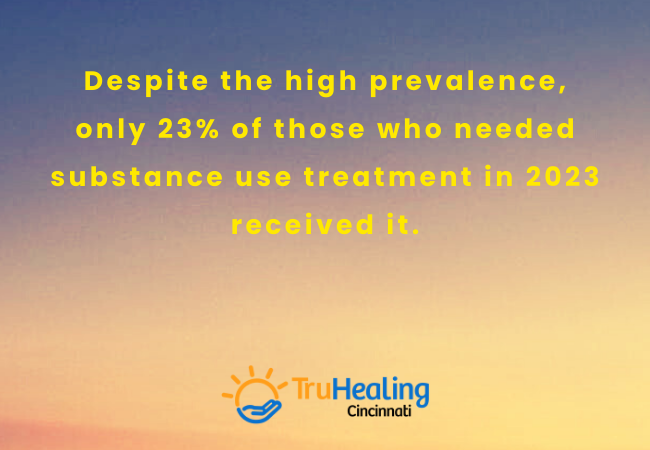Breaking free from drug or alcohol addiction is one of the most courageous decisions anyone can make. However, one of the first—and most intimidating—steps in recovery is detox. Whether you’re starting treatment at an inpatient facility, engaging in Outpatient Treatment In Cincinnati, or entering a Partial Hospitalization Treatment in Cincinnati, understanding what to expect during detox and withdrawal can empower you to navigate the process with confidence.
At TruHealing Cincinnati, we specialize in supporting individuals through every phase of recovery. In this guide, we’ll explore the symptoms, timeline, and coping strategies for detox and withdrawal, helping you or your loved one take that essential first step toward healing.
What Is Detox?
Detoxification, or detox, is the body’s natural process of eliminating toxins—such as drugs or alcohol—after you stop using them. This initial phase of addiction recovery is crucial, as it allows your body to physically stabilize before beginning therapy and long-term rehabilitation.
Depending on the substance used, the duration and severity of addiction, and overall physical health, detox can range from mildly uncomfortable to intensely challenging. That’s why medically supervised detox is highly recommended and often necessary for safety and comfort.
What Causes Withdrawal?
Withdrawal symptoms occur because the brain and body have become dependent on a substance. When you stop using it, your system struggles to regain balance. Neurochemical changes, especially those affecting dopamine and serotonin, can lead to a wide range of physical and psychological symptoms.
This is particularly true for individuals who have used substances like:
- Alcohol
- Opioids (e.g., heroin, prescription painkillers)
- Benzodiazepines
- Cocaine
- Methamphetamine
At a certified Addiction Treatment Center Cincinnati like TruHealing, we monitor clients throughout detox to reduce risks and ensure the safest possible experience.
Common Detox and Withdrawal Symptoms
Withdrawal symptoms vary based on the substance used, but here are some common examples:
Alcohol Withdrawal Symptoms
- Anxiety or depression
- Tremors or shaking
- Sweating
- Headaches
- Nausea and vomiting
- Insomnia
- Seizures (in severe cases)
- Delirium Tremens (DTs) – a life-threatening condition
Opioid Withdrawal Symptoms
- Muscle aches and cramps
- Runny nose and watery eyes
- Excessive yawning
- Nausea, vomiting, and diarrhea
- Cold sweats
- Insomnia
- Anxiety and irritability
Benzodiazepine Withdrawal Symptoms
- Rebound anxiety or panic attacks
- Sleep disturbances
- Muscle pain and stiffness
- Heart palpitations
- Hallucinations (in severe cases)
- Seizures
Stimulant Withdrawal Symptoms (e.g., cocaine, meth)
- Fatigue and sleepiness
- Depression or suicidal thoughts
- Increased appetite
- Slowed motor skills
- Cravings
Experiencing withdrawal without support can be dangerous. If you’re looking for professional help, Rehab centers in Cincinnati like TruHealing offer safe, medically supervised detox programs that prioritize both physical and emotional care.
Detox Timeline: What to Expect
The detox timeline can vary depending on the individual, but here’s a general overview based on the type of substance:
1. Alcohol
- 6–12 hours after last drink: Mild symptoms like anxiety and nausea
- 24–48 hours: Risk of seizures; need for medical monitoring
- 48–72 hours: DTs may appear; highest risk period
- 4–7 days: Symptoms begin to subside
2. Opioids (e.g., heroin, prescription painkillers)
- 8–24 hours: Symptoms start
- 1–3 days: Peak intensity
- 5–10 days: Gradual reduction in symptoms
- Weeks to months: Post-acute withdrawal syndrome (PAWS) may persist
3. Benzodiazepines
- 1–4 days: Symptoms begin
- 1–2 weeks: Peak symptoms; high seizure risk
- Weeks to months: Lingering anxiety, insomnia
4. Stimulants
- Few hours to 1 day: Crash begins (fatigue, low mood)
- 3–5 days: Peak withdrawal
- 1–2 weeks: Symptoms diminish, though cravings may persist
These timeframes are estimates and can differ greatly. Individualized Cincinnati addiction treatment can help ease symptoms and manage risks associated with detox.
Coping Strategies for Detox and Withdrawal
While detox is difficult, there are several strategies to make the process more manageable and less overwhelming:
1. Choose Medically Supervised Detox
This is the most important step. At a professional Addiction Treatment Center Cincinnati, clients receive 24/7 care from trained clinicians, including:
- Medication-assisted treatment (MAT)
- Intravenous fluids
- Nutritional support
- Constant monitoring for complications
- Crisis intervention
2. Stay Hydrated and Nourished
Addiction often leads to poor nutrition and dehydration. Eating balanced meals and drinking fluids can improve strength and reduce symptom severity.
3. Practice Breathing and Relaxation Techniques
Mindfulness, deep breathing, and guided meditation can reduce anxiety, panic, and insomnia during detox.
4. Lean on Your Support System
Whether it’s family, friends, or peers in a group setting, emotional support plays a critical role in getting through detox.
5. Begin Therapy as Soon as Possible
Psychological support is just as crucial as physical stabilization. At TruHealing Cincinnati, clients can begin therapy immediately following detox through Intensive Outpatient Treatment In Cincinnati or a Partial Hospitalization Treatment in Cincinnati to explore the root causes of their addiction.
What Comes After Detox?
Detox is only the beginning. Without follow-up care, many people relapse quickly. A successful recovery requires structured treatment, ongoing support, and relapse prevention strategies.
Post-Detox Programs in Cincinnati:
- Partial Hospitalization Program (PHP): Offers a structured day program while allowing you to return home in the evenings.
- Intensive Outpatient Program (IOP): Combines flexibility with accountability, perfect for those transitioning from detox or inpatient care.
- Outpatient Treatment In Cincinnati: Ideal for those with mild addictions or strong home support systems.
- Individual & Group Therapy: Helps uncover the emotional and psychological causes of addiction.
Each of these options is available at TruHealing Cincinnati—one of the leading Rehab centers in Cincinnati.
Why Choose TruHealing Cincinnati?
At TruHealing Cincinnati, we provide comprehensive Substance Abuse Treatment in Cincinnati that includes:
- Medically supervised detox
- MAT (Medication-Assisted Treatment)
- Individual, group, and family therapy
- Trauma-informed care
- Dual diagnosis support
- Aftercare planning
Our team understands the challenges of early recovery and walks alongside you every step of the way. As a trusted Drug Addiction Treatment in Cincinnati provider, our mission is to help individuals reclaim their lives and rediscover hope.
Final Thoughts
Detox and withdrawal are hard—but you are not alone. With the right medical support, coping strategies, and aftercare planning, you can take control of your recovery journey and build a fulfilling life in sobriety.
If you or a loved one is ready to take the first step, reach out to TruHealing Cincinnati today. Our compassionate team is here to guide you from detox through recovery and beyond. Contact us now 513.643.9118 to learn more about our Cincinnati addiction treatment programs and how we can help you start your journey to healing.
FAQ on Detox in Addiction Treatment
What is detox in addiction treatment?
Detox is the process of eliminating drugs or alcohol from the body. It’s the first step in addiction recovery and helps stabilize individuals physically before therapy begins. At TruHealing Cincinnati, detox is medically supervised to ensure safety and comfort.
How long does withdrawal last?
Withdrawal duration depends on the substance and individual factors. Most acute symptoms last 5 to 10 days, but some people may experience longer-lasting effects such as anxiety or cravings. A structured program like our Partial Hospitalization Treatment in Cincinnati can support recovery beyond detox.
Is detox dangerous without medical supervision?
Yes, detox can be dangerous—especially for substances like alcohol, opioids, or benzodiazepines. Risks include seizures, dehydration, or heart issues. Medically supervised detox at a reputable Addiction Treatment Center Cincinnati is the safest option.
What happens after detox?
After detox, it’s essential to continue with structured treatment to address the psychological and behavioral roots of addiction. Options include Intensive Outpatient Treatment In Cincinnati, Outpatient Treatment, or Partial Hospitalization Programs at TruHealing Cincinnati.
What are common withdrawal symptoms?
Common symptoms include anxiety, insomnia, nausea, sweating, body aches, depression, and cravings. Symptoms vary by substance and may range from mild to severe.
Can I detox at home?
Home detox is risky and not recommended for most people. Without medical supervision, complications can arise. Professional Substance Abuse Treatment in Cincinnati provides a safer, more comfortable detox experience with long-term support.


